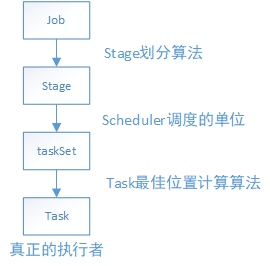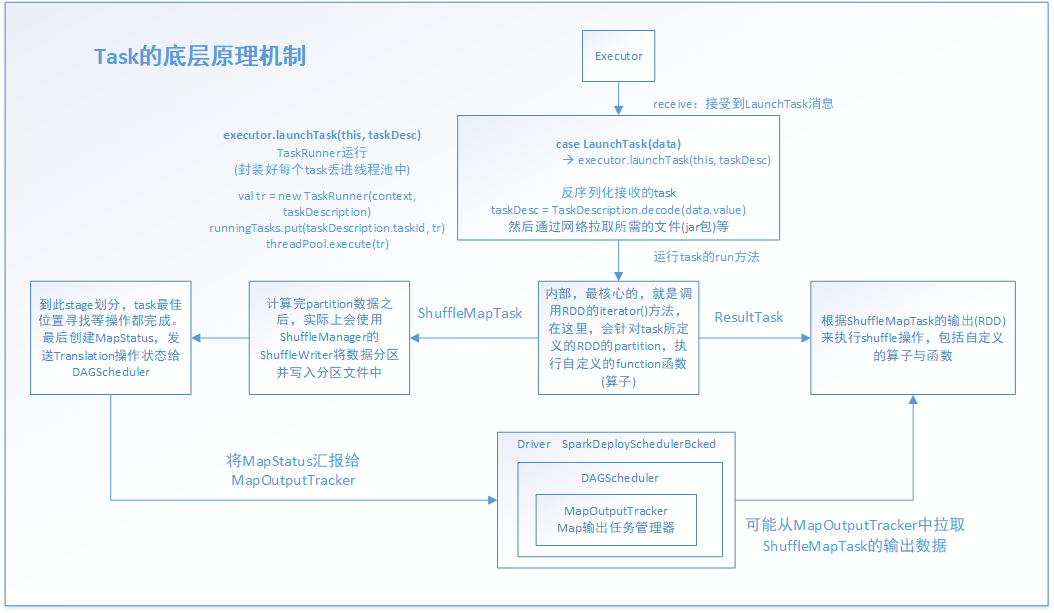Spark之Task原理分析


override def receive: PartialFunction[Any, Unit]
executor接受到这个事件消息后,task才真正开始工作。其中的executor.launchTask(this, taskDesc)就是主要的实现函数体
case LaunchTask(data) =>
if (executor == null) {
exitExecutor(, "Received LaunchTask command but executor was null")
} else {
val taskDesc = TaskDescription.decode(data.value)
logInfo("Got assigned task " + taskDesc.taskId)
executor.launchTask(this, taskDesc)
}
launchTask方法,主要是new出一个TaskRunner线程,并把它放进java的线程池中运行。通过这里也知道其实Spark的底层是依赖Java和Scala共同实现的。
def launchTask(context: ExecutorBackend, taskDescription: TaskDescription): Unit = {
val tr = new TaskRunner(context, taskDescription)
runningTasks.put(taskDescription.taskId, tr)
threadPool.execute(tr)
}
通过看TaskRunner的实现,知道它是继承Runnable的,因此,就知道线程真正的运行体是run()方法。
class TaskRunner(
execBackend: ExecutorBackend,
private val taskDescription: TaskDescription)
extends Runnable 下面是run( )方法的主要部分源码。
override def run(): Unit = {
threadId = Thread.currentThread.getId
Thread.currentThread.setName(threadName)
val threadMXBean = ManagementFactory.getThreadMXBean
val taskMemoryManager = new TaskMemoryManager(env.memoryManager, taskId)
val deserializeStartTime = System.currentTimeMillis()
val deserializeStartCpuTime = if (threadMXBean.isCurrentThreadCpuTimeSupported) {
threadMXBean.getCurrentThreadCpuTime
} else 0L
Thread.currentThread.setContextClassLoader(replClassLoader)
val ser = env.closureSerializer.newInstance()
logInfo(s"Running $taskName (TID $taskId)")
execBackend.statusUpdate(taskId, TaskState.RUNNING, EMPTY_BYTE_BUFFER)
var taskStart: Long =
var taskStartCpu: Long =
startGCTime = computeTotalGcTime()
try {
// Must be set before updateDependencies() is called, in case fetching dependencies
// requires access to properties contained within (e.g. for access control).
//对序列化的数据,进行反序列化
Executor.taskDeserializationProps.set(taskDescription.properties)
//通过网络通信的方法,把task运行所需要的文件、资源、jar等拉取过来
updateDependencies(taskDescription.addedFiles, taskDescription.addedJars)
//最后,通过正式的反序列化操作,将整个task的数据集拉取过来
//这里用ClassLoader的原因是通过指定的上下文资源,进行加载和读取。(当然,反射还有另外的功能:通过反射放射动态加载一个类,创建类的对象)
task = ser.deserialize[Task[Any]](
taskDescription.serializedTask, Thread.currentThread.getContextClassLoader)
task.localProperties = taskDescription.properties
task.setTaskMemoryManager(taskMemoryManager)
// If this task has been killed before we deserialized it, let's quit now. Otherwise,
// continue executing the task.
val killReason = reasonIfKilled
if (killReason.isDefined) {
// Throw an exception rather than returning, because returning within a try{} block
// causes a NonLocalReturnControl exception to be thrown. The NonLocalReturnControl
// exception will be caught by the catch block, leading to an incorrect ExceptionFailure
// for the task.
throw new TaskKilledException(killReason.get)
}
logDebug("Task " + taskId + "'s epoch is " + task.epoch)
env.mapOutputTracker.updateEpoch(task.epoch)
// Run the actual task and measure its runtime.
//计算task开始的时间
taskStart = System.currentTimeMillis()
taskStartCpu = if (threadMXBean.isCurrentThreadCpuTimeSupported) {
threadMXBean.getCurrentThreadCpuTime
} else 0L
var threwException = true
/**
* value 对于ShuffleMapTask来说,就是MapStatus
* 封装了ShuffleMapTask计算的数据,输出的位置
* 后面的ShuffleMapTask会去联系MapOutputTracker来获取一个ShuffleMapTask的输出位置,通过网络网络拉取数据
* ResultTask也是这样的,只不过是查询ShuffleMapTask的结果MapStatus的位置
* 总的来说 MapOutputTracker(Map输出任务管理器),把map和action联系起来了。
*/
val value = try {
//真正的task的线程执行方法,下面会详细分析
val res = task.run(
taskAttemptId = taskId,
attemptNumber = taskDescription.attemptNumber,
metricsSystem = env.metricsSystem)
threwException = false
res
} finally {
val releasedLocks = env.blockManager.releaseAllLocksForTask(taskId)
val freedMemory = taskMemoryManager.cleanUpAllAllocatedMemory()
if (freedMemory > && !threwException) {
val errMsg = s"Managed memory leak detected; size = $freedMemory bytes, TID = $taskId"
if (conf.getBoolean("spark.unsafe.exceptionOnMemoryLeak", false)) {
throw new SparkException(errMsg)
} else {
logWarning(errMsg)
}
}
if (releasedLocks.nonEmpty && !threwException) {
val errMsg =
s"${releasedLocks.size} block locks were not released by TID = $taskId:\n" +
releasedLocks.mkString("[", ", ", "]")
if (conf.getBoolean("spark.storage.exceptionOnPinLeak", false)) {
throw new SparkException(errMsg)
} else {
logInfo(errMsg)
}
}
}
task.context.fetchFailed.foreach { fetchFailure =>
// uh-oh. it appears the user code has caught the fetch-failure without throwing any
// other exceptions. Its *possible* this is what the user meant to do (though highly
// unlikely). So we will log an error and keep going.
logError(s"TID ${taskId} completed successfully though internally it encountered " +
s"unrecoverable fetch failures! Most likely this means user code is incorrectly " +
s"swallowing Spark's internal ${classOf[FetchFailedException]}", fetchFailure)
}
//task结束的时间
val taskFinish = System.currentTimeMillis()
val taskFinishCpu = if (threadMXBean.isCurrentThreadCpuTimeSupported) {
threadMXBean.getCurrentThreadCpuTime
} else 0L
// If the task has been killed, let's fail it.
task.context.killTaskIfInterrupted()
//对MapStatus进行各种序列化和封装,后面要发送给MapOutputTracker
val resultSer = env.serializer.newInstance()
val beforeSerialization = System.currentTimeMillis()
val valueBytes = resultSer.serialize(value)
val afterSerialization = System.currentTimeMillis()
// Deserialization happens in two parts: first, we deserialize a Task object, which
// includes the Partition. Second, Task.run() deserializes the RDD and function to be run.
/**
* 计算出task的一些统计信息,运行时间/反序列化消耗的时间/Java虚拟机 GC消耗的时间/反序列化消耗的时间
*/
task.metrics.setExecutorDeserializeTime(
(taskStart - deserializeStartTime) + task.executorDeserializeTime)
task.metrics.setExecutorDeserializeCpuTime(
(taskStartCpu - deserializeStartCpuTime) + task.executorDeserializeCpuTime)
// We need to subtract Task.run()'s deserialization time to avoid double-counting
task.metrics.setExecutorRunTime((taskFinish - taskStart) - task.executorDeserializeTime)
task.metrics.setExecutorCpuTime(
(taskFinishCpu - taskStartCpu) - task.executorDeserializeCpuTime)
task.metrics.setJvmGCTime(computeTotalGcTime() - startGCTime)
task.metrics.setResultSerializationTime(afterSerialization - beforeSerialization)
// Note: accumulator updates must be collected after TaskMetrics is updated
val accumUpdates = task.collectAccumulatorUpdates()
// TODO: do not serialize value twice
val directResult = new DirectTaskResult(valueBytes, accumUpdates)
val serializedDirectResult = ser.serialize(directResult)
val resultSize = serializedDirectResult.limit
// directSend = sending directly back to the driver
//下面是对map结果做序列化和对其做位置等信息的封装,方便网络传输和位置查找。注意,BlockManager 是Spark底层的内存,数据,磁盘数据管理的组件
val serializedResult: ByteBuffer = {
if (maxResultSize > && resultSize > maxResultSize) {
logWarning(s"Finished $taskName (TID $taskId). Result is larger than maxResultSize " +
s"(${Utils.bytesToString(resultSize)} > ${Utils.bytesToString(maxResultSize)}), " +
s"dropping it.")
ser.serialize(new IndirectTaskResult[Any](TaskResultBlockId(taskId), resultSize))
} else if (resultSize > maxDirectResultSize) {
val blockId = TaskResultBlockId(taskId)
env.blockManager.putBytes(
blockId,
new ChunkedByteBuffer(serializedDirectResult.duplicate()),
StorageLevel.MEMORY_AND_DISK_SER)
logInfo(
s"Finished $taskName (TID $taskId). $resultSize bytes result sent via BlockManager)")
ser.serialize(new IndirectTaskResult[Any](blockId, resultSize))
} else {
logInfo(s"Finished $taskName (TID $taskId). $resultSize bytes result sent to driver")
serializedDirectResult
}
}
//调用executor所在的ScoresGrainedExecutorBackend的statusUpdate,更新状态信息
setTaskFinishedAndClearInterruptStatus()
execBackend.statusUpdate(taskId, TaskState.FINISHED, serializedResult)
} catch {
case t: Throwable if hasFetchFailure && !Utils.isFatalError(t) =>
val reason = task.context.fetchFailed.get.toTaskFailedReason
if (!t.isInstanceOf[FetchFailedException]) {
// there was a fetch failure in the task, but some user code wrapped that exception
// and threw something else. Regardless, we treat it as a fetch failure.
val fetchFailedCls = classOf[FetchFailedException].getName
logWarning(s"TID ${taskId} encountered a ${fetchFailedCls} and " +
s"failed, but the ${fetchFailedCls} was hidden by another " +
s"exception. Spark is handling this like a fetch failure and ignoring the " +
s"other exception: $t")
}
setTaskFinishedAndClearInterruptStatus()
execBackend.statusUpdate(taskId, TaskState.FAILED, ser.serialize(reason))
executor的task.run,底层主要是task的run方法,很明显看出来,主要工作是创建一个context,把task运行过程中的上下文记录下来。其中关键的是调用抽象方法,runTask。
final def run(
taskAttemptId: Long,
attemptNumber: Int,
metricsSystem: MetricsSystem): T = {
SparkEnv.get.blockManager.registerTask(taskAttemptId)
//创建 context ,task的执行上下文,里面记录task执行的全局性的数据
//重试次数,task属于哪个stage,task要处理的是哪个rdd,哪个partition等
context = new TaskContextImpl(
stageId,
partitionId,
taskAttemptId,
attemptNumber,
taskMemoryManager,
localProperties,
metricsSystem,
metrics)
TaskContext.setTaskContext(context)
taskThread = Thread.currentThread() if (_reasonIfKilled != null) {
kill(interruptThread = false, _reasonIfKilled)
} new CallerContext(
"TASK",
SparkEnv.get.conf.get(APP_CALLER_CONTEXT),
appId,
appAttemptId,
jobId,
Option(stageId),
Option(stageAttemptId),
Option(taskAttemptId),
Option(attemptNumber)).setCurrentContext() try {
//调用抽象方法,runTask
runTask(context)
} catch {
case e: Throwable =>
// Catch all errors; run task failure callbacks, and rethrow the exception.
try {
context.markTaskFailed(e)
} catch {
case t: Throwable =>
e.addSuppressed(t)
}
context.markTaskCompleted(Some(e))
throw e
} finally {
try {
// Call the task completion callbacks. If "markTaskCompleted" is called twice, the second
// one is no-op.
context.markTaskCompleted(None)
} finally {
try {
Utils.tryLogNonFatalError {
// Release memory used by this thread for unrolling blocks
SparkEnv.get.blockManager.memoryStore.releaseUnrollMemoryForThisTask(MemoryMode.ON_HEAP)
SparkEnv.get.blockManager.memoryStore.releaseUnrollMemoryForThisTask(
MemoryMode.OFF_HEAP)
// Notify any tasks waiting for execution memory to be freed to wake up and try to
// acquire memory again. This makes impossible the scenario where a task sleeps forever
// because there are no other tasks left to notify it. Since this is safe to do but may
// not be strictly necessary, we should revisit whether we can remove this in the
// future.
val memoryManager = SparkEnv.get.memoryManager
memoryManager.synchronized { memoryManager.notifyAll() }
}
} finally {
// Though we unset the ThreadLocal here, the context member variable itself is still
// queried directly in the TaskRunner to check for FetchFailedExceptions.
TaskContext.unset()
}
}
}
}
task是抽象方法,意味着这个类只是模板类,仅仅封装了一些子类通用的属性和方法,依赖于子类实现它们,来确定具体的功能。 前面说过task的有两个子类ShuffleMapTask和ResultTask。有了它们,才能运行定义的算子和逻辑
def runTask(context: TaskContext): T def preferredLocations: Seq[TaskLocation] = Nil // Map output tracker epoch. Will be set by TaskSetManager.
var epoch: Long = - // Task context, to be initialized in run().
@transient var context: TaskContextImpl = _ // The actual Thread on which the task is running, if any. Initialized in run().
@volatile @transient private var taskThread: Thread = _ // If non-null, this task has been killed and the reason is as specified. This is used in case
// context is not yet initialized when kill() is invoked.
@volatile @transient private var _reasonIfKilled: String = null protected var _executorDeserializeTime: Long =
protected var _executorDeserializeCpuTime: Long = /**
* If defined, this task has been killed and this option contains the reason.
*/
def reasonIfKilled: Option[String] = Option(_reasonIfKilled) /**
* Returns the amount of time spent deserializing the RDD and function to be run.
*/
def executorDeserializeTime: Long = _executorDeserializeTime
def executorDeserializeCpuTime: Long = _executorDeserializeCpuTime /**
* Collect the latest values of accumulators used in this task. If the task failed,
* filter out the accumulators whose values should not be included on failures.
*/
def collectAccumulatorUpdates(taskFailed: Boolean = false): Seq[AccumulatorV2[_, _]] = {
if (context != null) {
// Note: internal accumulators representing task metrics always count failed values
context.taskMetrics.nonZeroInternalAccums() ++
// zero value external accumulators may still be useful, e.g. SQLMetrics, we should not
// filter them out.
context.taskMetrics.externalAccums.filter(a => !taskFailed || a.countFailedValues)
} else {
Seq.empty
}
}
到此,task整个运行流程已分析一遍,最后,调用下面的函数来更新状态信息
setTaskFinishedAndClearInterruptStatus()
execBackend.statusUpdate(taskId, TaskState.FINISHED, serializedResult)
最后来总结一下,task的运行一开始不是直接调用底层的task的run方法直接处理job-->stage-->taskSet-->task这条路线的task任务的,它是通过分层和分工的思想来完成。task会派生出两个子类ShuffleMapTask和ResultTask分别完成对应的工作,ShuffleMapTask主要是对task所拥有的的RDD的partition做对应的RDD转换工作,ResultTask主要是根据action动作触发,并拉取ShuffleMapTask阶段的结果做进一步的算子和逻辑函数对数据的进一步处理。这两个阶段是通过MapOutputTracker来连接起来的。
Spark之Task原理分析的更多相关文章
- 小记--------spark的worker原理分析及源码分析
- 小记--------spark内核架构原理分析
首先会将jar包上传到机器(服务器上) 1.在这台机器上会产生一个Application(也就是自己的spark程序) 2.然后通过spark-submit(shell) 提交程序 ...
- [Spark性能调优] 第一章:性能调优的本质、Spark资源使用原理和调优要点分析
本課主題 大数据性能调优的本质 Spark 性能调优要点分析 Spark 资源使用原理流程 Spark 资源调优最佳实战 Spark 更高性能的算子 引言 我们谈大数据性能调优,到底在谈什么,它的本质 ...
- spark 性能调优(一) 性能调优的本质、spark资源使用原理、调优要点分析
转载:http://www.cnblogs.com/jcchoiling/p/6440709.html 一.大数据性能调优的本质 编程的时候发现一个惊人的规律,软件是不存在的!所有编程高手级别的人无论 ...
- 性能调优的本质、Spark资源使用原理和调优要点分析
本课主题 大数据性能调优的本质 Spark 性能调优要点分析 Spark 资源使用原理流程 Spark 资源调优最佳实战 Spark 更高性能的算子 引言 我们谈大数据性能调优,到底在谈什么,它的本质 ...
- Spark原理分析目录
1 Spark原理分析 -- RDD的Partitioner原理分析 2 Spark原理分析 -- RDD的shuffle简介 3 Spark原理分析 -- RDD的shuffle框架的实现概要分析 ...
- 20、Task原理剖析与源码分析
一.Task原理 1.图解 二.源码分析 1. ###org.apache.spark.executor/Executor.scala /** * 从TaskRunner开始,来看Task的运行的工作 ...
- Spark中Task数量的分析
本文主要说一下Spark中Task相关概念.RDD计算时Task的数量.Spark Streaming计算时Task的数量. Task作为Spark作业执行的最小单位,Task的数量及运行快慢间接决定 ...
- 深度剖析Spark分布式执行原理
让代码分布式运行是所有分布式计算框架需要解决的最基本的问题. Spark是大数据领域中相当火热的计算框架,在大数据分析领域有一统江湖的趋势,网上对于Spark源码分析的文章有很多,但是介绍Spark如 ...
随机推荐
- [BestCoder Round #5] hdu 4956 Poor Hanamichi (数学题)
Poor Hanamichi Time Limit: 2000/1000 MS (Java/Others) Memory Limit: 32768/32768 K (Java/Others) T ...
- swift - UISlider 的用法
swift的UISlider的用法和oc基本没有区别 1.创建 class SecondViewController: UIViewController { var slider = UISlider ...
- ios 在https情况下,使用webview加载url出错的解决方法 ios9 适配问题
修改info.plist文件,添加App Transport Security Settings,然后在这个里面添加Allow Arbitrary Loads,改为yes 如下图:
- RF常用快捷键
转自:http://www.robotframework.net/article/47 重命名——>F2 搜索关键字——>F5 执行用例——>F8 创建新工程——>ctrl+n ...
- redis安装之zmalloc.h:55:2: error: #error "Newer version of jemalloc required"错误
redis是C语言编写的软件,安装前需要编译,需要gcc编译环境,确认安装gcc编译环境后(安装gcc命令:yum install gcc-c++) 在redis解压目录下,确认有Makefile文件 ...
- Python 使用正则表达式匹配URL网址
使用正则表达式匹配以 .com 或 .cn 为域名后缀的URL地址 In [1]: import re In [2]: str = "http://www.baidu.com/" ...
- date类型数据插入
--字段类型是dateinsert into tab(column) values(to_date('2017_06_30 11:38:22','yyyy-mm-dd hh24:mi:ss'));-- ...
- javascript中五种基本数据类型
前言: JavaScript中有五种基本数据类型(也叫做简单数据类型)分别为:undefined.null.bolean.number.string:另外还含有一种复杂的数据类型:object. 深入 ...
- c++11实现异步定时器
c++11提供了丰富的时间和线程操作函数,比如 std::this_thread::sleep, std::chrono::seconds等.可以利用这些来很方便的实现一个定时器. 定时器要求 ...
- poj_3168 平面扫描
题目大意 给定平面上N个矩形的位置(给出矩形的左下角和右上角的坐标),这些矩形有些会有重叠,且重叠只会出现矩形的边重合全部或部分,矩形的顶点重合,而不会出现一个矩形的顶点位于另一个矩形的内部. ...
